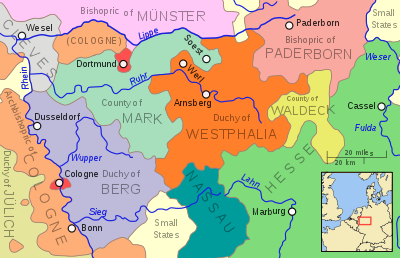- Duchy of Westphalia
-
The Duchy of Westphalia was a historic territory in the greater region of Westphalia, located in the east of modern North Rhine-Westphalia, Germany. Originally, Westphalia formed with Angria and Eastphalia one of the three main regions of Saxony. For most of its history, the duchy was held by the Archbishop and Electorate of Cologne.
Contents
Creation of the Duchy of Westphalia (1102-1180)
Frederick I, the Archbishop of Cologne, had acquired half of the County of Arnsberg in 1102. The other counties of the region could not resist the encroachment of the Archbishopric, and soon after the counties of Werl, Reuthen and Volmarstein followed. The former count of Arnsberg created a new County known as Werl-Arnsberg, and successfully kept it independent of the Archbishops. When Henry the Lion of Saxony was defeated in 1180, the Holy Roman Emperor Frederick I Barbarossa promoted Philip I of Heinsberg, and officially gave to him these territories and the south of the former Duchy of Saxony as the Duchy of Westphalia.
Expansion of the Duchy (1180-1445)
The Archbishop of Cologne, Engelbert of Berg began a campaign to force the nobility in Westphalia into submission and to extract from them the stewardship of the various scattered church lands. Engelbert managed to connect the lands of the Duchy by annexing the territory from Hellweg to Diemel, and secured the south of the Sauerland at Attendorn in 1222. Further controversy of its expansion eventually leads to Engelbert's death at the hands of Frederick I of Isenberg in 1225. In 1260 by an agreement with the Dukes of Brunswick the Weser River became the official border of their spheres of influence. In 1277 the Archbishops managed to defeat a large confederation of Westphalian and Lower Rhenish opponents, but further action in 1288 forced the Archbishops to abandon intentions on much of the greater territory of Westphalia. The annexation of Werl-Arnsberg in 1368 united the territories of the north and south of the Sauerland.
The Archbishop Frederick von Saarwerden began a hopeless campaign to maintain Colognian rights in Marck, and in 1392 was forced to abandon them. His successor, Dietrich II of Moers witnessed the last attempts by Cologne to gain rulership in Westphalia by attempting to break the powerful positions of Cleves and Marck. The financial burden placed upon the knights and cities of the Duchy of Westphalia led them into union in 1437. Cologne made peace with Cleves in 1441: this led Soest, the richest town of the duchy, to refuse recognising Colognian supremacy in 1444 in the Soester Feud, that lasted until 1449. Soest had become a part of the Duchy of Cleves. Thereafter the town of Arnsberg became the administrative capital of the duchy. Economically the loss of Soest had weakened the duchy. Especially as the surroundings of the town were very fertile and the grain was needed for the mountainous regions in the South. Peace with Marck was made in 1445 which witnessed territorial concessions from both sides.
 Arms of Westphalia (adopted in 1532).
Arms of Westphalia (adopted in 1532).Westphalia until the end of the Empire (1445-1806)
After the Soester Feud, the city of Soest remained part of the Duchy of Cleves. Starting from 1463, the league of knights and cities in Westphalia began a long and bitter struggle against the Archbishops. During the reign of Archbishop Herman V of Wied (1515-1546), the Reformation arrived in Westphalia. Eventually the Reformation was suppressed, but during the reign of Archbishop Gebhard Truchsess von Waldburg (1577-1583) the Reformation returned and he was forced to attend to Westphalia in 1582 where several knights and cities had adopted the new doctrine. The newly elected Archbishop Ernest of Bavaria (1583-1612) and his brother Ferdinand of Bavaria managed to regain the Duchy for the Archbishopric at the beginning of the Cologne War in 1583, and Protestantism survived only on the border region of Waldeck and Hesse. The Duchy of Westphalia was again confirmed as integral territory of the Archbishopric in 1590.
Like most other territories of Germany, Westphalia suffered during the Thirty Years' War. In 1794 the Archbishops relocated to Westphalia after the French had annexed the territories west of the Rhine River. In the secularisation of 1803 the Duchy of Westphalia became part of Hesse-Darmstadt.
The Duchy after the Empire (1806-1815)
In 1807 the newly created Kingdom of Westphalia was created although it did not include the Duchy and had its capital in Hesse at Kassel. The Congress of Vienna awarded the Duchy of Westphalia to Prussia in exchange for important lands west of the Rhine, and the Duchy was incorporated into the Province of Westphalia in 1815.
See also
Sources
 This article incorporates text from a publication now in the public domain: Herbermann, Charles, ed (1913). Catholic Encyclopedia. Robert Appleton Company.
This article incorporates text from a publication now in the public domain: Herbermann, Charles, ed (1913). Catholic Encyclopedia. Robert Appleton Company.
This page uses content from HistoryWiki at Duchy of Westphalia. The list of authors can be seen in the page history. As with Wikipedia, the text of HistoryWiki is available under the CC-By-SA.
External links
Categories:- States of the Holy Roman Empire
- History of North Rhine-Westphalia
- States and territories established in 1180
- Westphalia
Wikimedia Foundation. 2010.

